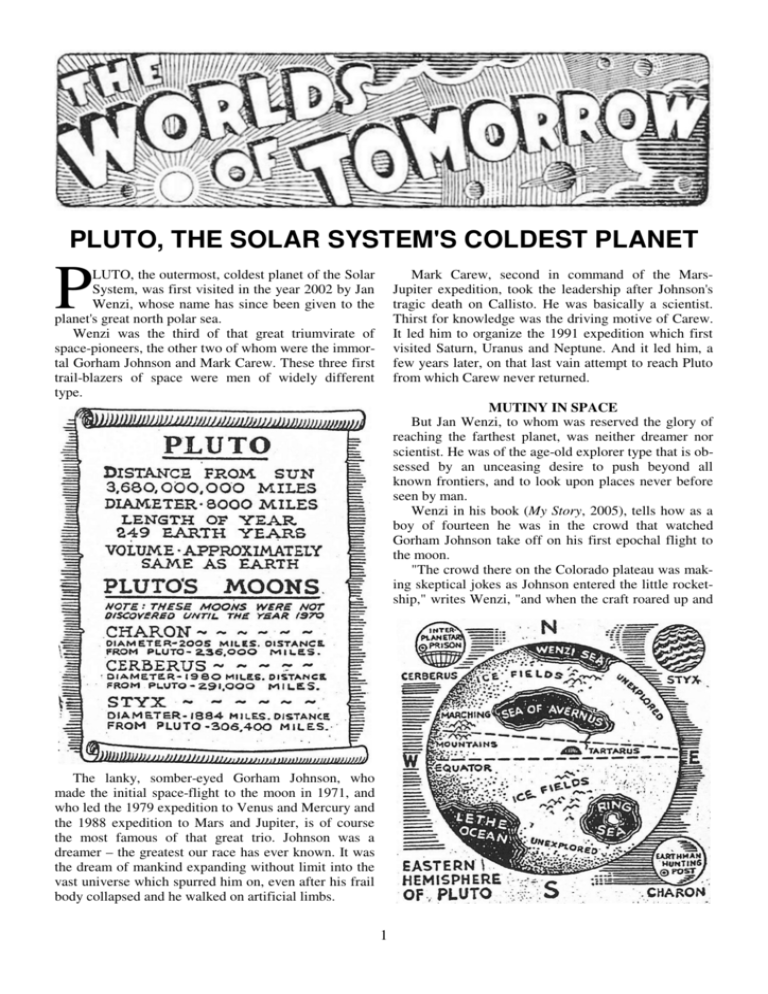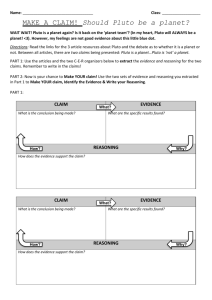PLUTO, THE SOLAR SYSTEM'S COLDEST PLANET
advertisement

PLUTO, THE SOLAR SYSTEM'S COLDEST PLANET P LUTO, the outermost, coldest planet of the Solar System, was first visited in the year 2002 by Jan Wenzi, whose name has since been given to the planet's great north polar sea. Wenzi was the third of that great triumvirate of space-pioneers, the other two of whom were the immortal Gorham Johnson and Mark Carew. These three first trail-blazers of space were men of widely different type. Mark Carew, second in command of the MarsJupiter expedition, took the leadership after Johnson's tragic death on Callisto. He was basically a scientist. Thirst for knowledge was the driving motive of Carew. It led him to organize the 1991 expedition which first visited Saturn, Uranus and Neptune. And it led him, a few years later, on that last vain attempt to reach Pluto from which Carew never returned. MUTINY IN SPACE But Jan Wenzi, to whom was reserved the glory of reaching the farthest planet, was neither dreamer nor scientist. He was of the age-old explorer type that is obsessed by an unceasing desire to push beyond all known frontiers, and to look upon places never before seen by man. Wenzi in his book (My Story, 2005), tells how as a boy of fourteen he was in the crowd that watched Gorham Johnson take off on his first epochal flight to the moon. "The crowd there on the Colorado plateau was making skeptical jokes as Johnson entered the little rocketship," writes Wenzi, "and when the craft roared up and The lanky, somber-eyed Gorham Johnson, who made the initial space-flight to the moon in 1971, and who led the 1979 expedition to Venus and Mercury and the 1988 expedition to Mars and Jupiter, is of course the most famous of that great trio. Johnson was a dreamer – the greatest our race has ever known. It was the dream of mankind expanding without limit into the vast universe which spurred him on, even after his frail body collapsed and he walked on artificial limbs. 1 vanished there was much comment to the effect that a crazy man had found a unique method of committing suicide. But I knew, as I looked up into the sky after the vanished ship, that some day I too was going to go out there and look on worlds never seen before by Earthmen." When Gorham Johnson returned from the moon, and was greeted by such a wild reception as no hero had ever before been accorded, Wenzi tried frantically to enlist in the coming Venus-Mercury expedition. But his youth, and lack of technical training, prevented this. Nothing daunted, the intrepid pioneer applied himself to technical studies and succeeded in joining the Mars-Jupiter expedition of 1988. He was one of the few of the crew who remained loyal to Johnson and Carew when the crew threatened mutiny at going beyond Mars. After Johnson's death on Callisto, when the expedition landed on Jupiter, Wenzi was one of the first Earth-men to step onto that mighty world. And there, rashly, venturing alone into the jungle, he was attacked by a Jovian "crawler," and so seriously injured that he almost died on the way back to Earth. Uranus so aggravated his old hurts that for four years he lay in an Earth hospital, apparently hopelessly crippled, and sending innumerable pitiful messages to his idol. Thus, when Carew rocketed away again in 1994 in an attempt to reach Pluto, Wenzi could not go and was forced to lie on a hospital cot in utter misery at not being able to be along. By 1999, Carew had been given up for lost, since he had not returned nor sent back any word. The general belief was that Pluto was too far to be reachable as yet, and public attention turned toward the more easily accessible worlds of Mars and Venus and Jupiter, where Earthmen were beginning to stream out to build colonial cities and trade with the native races. In this great fever of colonization, Pluto was more or less forgotten. But Jan Wenzi had not forgotten. The old fever of space-exploration gripped him as strongly as ever. He had been released from hospital by that year, but he was badly crippled, unable to walk more than a few steps at a time, his hair graying even at the age of fortytwo from long hardship and suffering. Yet he had determined to reach Pluto. There was general criticism when Wenzi began forming his Pluto Expedition, because of his physical disabilities and the enormous difficulties of the project. Armchair space-travelers pointed out the impossibility of the whole attempt. Scientists weightily listed the EXPEDITION TO PLUTO Wenzi's injuries did not prevent him from joining Mark Carew in the historic 1991 expedition to Saturn, Uranus and Neptune. But a fall while exploring on 2 tremendous obstacles to success in such an undertaking, and the public as a whole had no belief whatever in its soundness. Wenzi was mocked and satirized in cartoons and on the theatrical stage. But a few believed in Wenzi. They were old spacemen like himself, men who had rocketed with him in past years and knew his indomitable spirit better than the public. They came in answer to his call. With eleven men, in the ship he had called the Johnson, Wenzi blasted off for Pluto on January 12, 2000. little colony – men, women, and two infants – being wiped out by one of the ferocious equatorial blizzards. It was seen that an Earthman colony would need elaborate protection against the cold and storms of the icy planet. So, in 2011, a more ambitious colonizing attempt was made. A large glassite dome was set up and airconditioned by atomic machinery, and inside this dome was built the city appropriately named Tartarus. The domed cities of Elysia and Newton were built nearby soon after, and other Earthmen cities arose shortly on the other side of the planet. Cerberus, until then rarely visited, was designated by the System Government as the site of an Interplanetary Prison, in 2012. Charon, was even less often visited, because of the nightmare ferocity of its animal life. Styx, the third moon, had been ignored from the first because it was plain to be seen it was completely watercovered. THE MYSTERIOUS ISLAND The brave explorer refueled and restocked supplies at the new post on Saturn. From there he vanished out into the vast empty outer spaces of the System. Not one person in a million expected him ever to return. But return he did – four years later the crippled commander and four surviving men came roaring back to the inner planets in their battered ship. He had achieved his great ambition – he bad been first on Pluto. Wenzi lived only a year after his return to Earth. The government had decorated him, but refused to permit him to leave the hospital in which he was a virtual invalid, chafing at the inaction, he wasted away and soon died. The last words muttered by the indomitable explorer were, "Blast off!" Wenzi's expedition had found Pluto a frigid, icy world, but one where hardy Earthmen could live. Icefields covered almost the whole planet except a narrow equatorial region of frozen plains, and the great seas whose salt-content was so high that they remained unfrozen. Wenzi had also been the first to discover the Marching Mountains, those amazing, titanic glaciers that move around the planet in a regular path. He had penetrated as far southwest as the shores of the Lethe Ocean, and as far southeast as the curious Ring Sea, whose whirling tide circled a great central, mountainous island that has never been successfully explored. None to this day have visited that mysterious island and returned. EARTH'S NEW COLONY The Earthman colony on Pluto has flourished, but growth has not been fast. The vast distance from the inner planets has necessitated design of a wholly new type of spaceship with great cruising-radius. Also, distance from the sun so weakens the ultraviolet and other necessary solar radiation that Earthmen find it necessary to resort to periodical exposure to artificial therapeutic vibrations to counteract this lack. Temperament and character also, on the outer planets, suffers curious alterations. Chief exports from Pluto, beside the furs that are famous through the whole System, are such valuable metals as cadmium, vanadium, tungsten and others. There are small radium mines north of Lethe Ocean but they produce but little compared to the great uranium and radium industry of Jupiter. There is a certain demand from planetary zoos for the bizarre Plutonian animals, which must, of course, be kept in refrigerated cages. It is probable that when more of Pluto's icy surface is explored, new sources of valuable exports will be found. One curious feature that must be mentioned in connection with this distant planet is the strange mental affliction which the System psychiatrists call "Plutomania." Earthmen and other people of the inner planets who stay long on the icy world are liable to develop a queer psychosis that is manifested as an hysterical craving for light. This malady arises, of course, from the eternal dusk of this world. Venusians, accustomed to more light than Earthmen, are affected more quickly. Mercurians are so strongly affected that few of that race have ever visited the planet. ICE-CITIES OF A FROZEN WORLD Wenzi had also found the strange ice-cities of the native Plutonians and had established friendly contact with that hairy race. He brought back tales of the enormous animals that rove the ice-fields, or biburs and icebears and ice-cats and other huge furred beasts. Also, he brought back samples of minerals and precious stones blasted from the frozen plains, which were badly needed on Earth. The lure of furs and gems and precious minerals led further explorers to Pluto, and in 2008 an attempt was made to establish a colony there. The attempt failed, the 3








